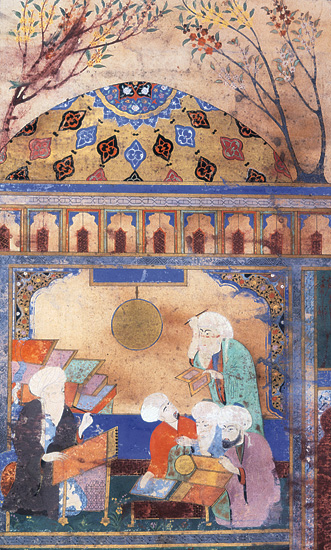the Rasatkhana, which means ‘star-house’ or observatory; but none had ever seen it
On the 17th of October 1933, Robert Byron visited the Rasatkhana, or better, the place where the Rasatkhana used to be. His visit was brief, presumably, since nothing of the once famous observatory remains. Apparently, he did not take even one photo.
In his travelogue, though, the author recognizes the importance of the site writing that “it was built by Hulagu in the thirteenth century, and its observations were Islam’s last contribution to astronomy till Ulugh Beg revised the calendar at the beginning of the fifteenth”. Byron’s visit allows us to discuss one of the most popular topic of the Arab-Islamic history (and a topic I rarely take into consideration): astronomy!
Founded in 1259 by the Mongol prince Hülegü Khan, grandson of Gengis Khan, the fame of the Observatory of Maragha is linked to Nasir al-Din al-Tusi, the Persian mathematician and astronomer. Al-Tusi was Hulegu’s advisor and the director and designer of the observatory. It is said that al-Tusi once complained to the prince that the astronomical tables he was using were 250 years old, and the prince asked the astronomer to chose a spot where to build a new observatory so that he could compile new tables. He chose Maragha, a city in North-West Iran, about 130 km from Tabriz.

The central structure, which is considered to be the main building of the observatory, is circular. Its entrance opens into a wide corridor that marks the meridian line. On the two sides of the corridors, there are 6 rooms. Around the main building, other constructions were to be found: the buildings were probably the library, other observation posts and apparently the workshops where the instruments and tools were assembled. Also, the observatory included a complex where visiting scholars and students were hosted. In this regard, it is a pity that the majority of studies, so far, have focused either on the mechanics of the new mathematical theories that were developed there or on the physical constructions of the buildings and the instruments used: much can be learnt from a detailed study of the social make-up of the observatory.
The Rasatkhana of Maraghah represents the new wave of scientific activities in the Islamic world that took place in the 13th century. There, al-Tusi and his collaborators, compiled the Ilkhani Zij, the most important Islamic astronomical tables.

The importance of this observatory was huge, not only for Islamic astronomy but also for the European one: Maraghah heavily influenced the astronomical revolution in the 16th century. The observatory of Maraghah was the first one proposing models alternative to the Ptolemaic, geocentric one. These models, together with other innovations from Samarqand and Damascus, arrived in Europe and formed a critical part of the mathematical tools that enabled Copernicus to create the heliocentric model of the universe.
After the death of al-Tusi, his son continued the work in the observatory, but with the beginning of the 14th century, the observatory became inactive.
Today it is an archaeological site, when one can simply imagine how it used to be. As we perceive from Byron’s words, we can only assume how al-Tusi’s observatory used to be: “a level table, where various mounds were approached from four points of the compass by straight cobbled paths intersecting at right angles. These paths, we supposed, were constructed to assist astronomical calculations; the mounds were the remains of buildings.”
Sources
Unesco, “Maragheh observatory, Iran”, in Unesco Astronomy and World Heritage Web portal, available online [last accessed: 5th Oct 2017]
Hadi Jorati, “The Maragha Observatory Complex in Ilkhanid Iran”, in Max Planck Institute for the History of Science website, available online [last accessed: 5th Oct 2017]
One Comment Add yours